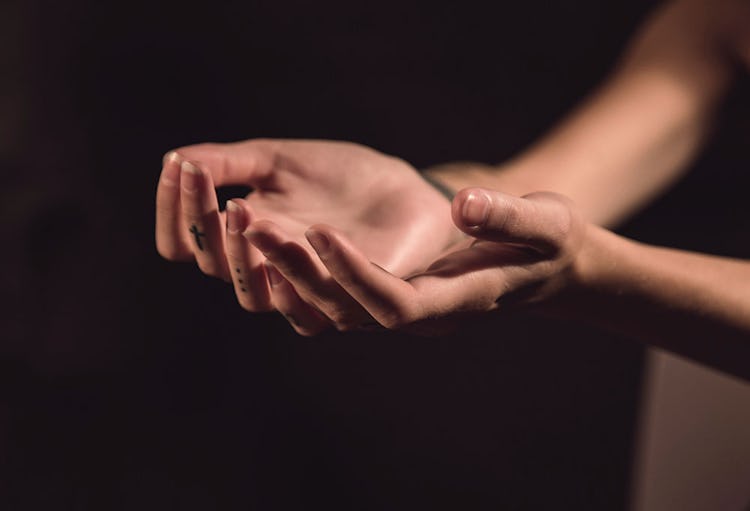When someone says he can heal you with the touch of a hand… run. (Unless you can somehow verify that the person is, in fact, Jesus Christ, or some other being with divine powers.) Nevertheless, as weird and woo-woo as it sounds, Reiki—a Japanese method of hands-on energy healing—has a devoted following, and delving into the research on its effectiveness yields some surprising findings.
We investigated the Reiki phenomenon to determine what’s fact, and what’s wack.
What is Reiki Meditation?

Pronounced “ray key,” the term Reiki is a combination of the Japanese words rei, meaning spirit, divine, or mysterious, and ki, the word for one’s vital energy, consciousness, or, as the Japanese say, “breath of life.” Similar to Chinese acupuncture, the premise behind Reiki is that if your ki levels are low or blocked, you’re more susceptible to stress and illness. A Reiki practitioner will lay his or her hands on areas of your body that need a ki adjustment, and that supposedly reduces stress and promotes relaxation and healing. That’s right: they touch you and you feel better. Reiki treatments are called meditations.
Reiki practitioners don’t recommend Reiki as a replacement for Western medicine practices—especially for those diagnosed with serious conditions—but claim it serves as a useful adjunct to more conventional therapies. Anyone can learn Reiki, as it’s not really a skill that’s taught, but rather an ability that’s passed on via a transfer called an “attunement,” in which a Reiki master allows his/her student to access ki.
Still with us? It gets weirder…
What are the 5 Principles of Reiki?
While Reiki is a spiritual practice, it doesn’t come with a particular religion or well-defined dogma. Practitioners say you don’t even need to believe in it for it to work. However, like other Eastern philosophies, Reiki does encourage being a good person and living in harmony with your surroundings.
To ensure that Reiki meditations have a lasting effect, practitioners insist that clients live by five principles. Boiled down and translated, they are:
1. Don’t get angry
2. Don’t worry
3. Be grateful
4. Work hard
5. Be kind to others
Where Does Reiki Come From?

On the surface, it seems like Reiki might be ancient, as other mystical practices tend to be. In actuality, it’s anything but.
Reiki is relatively new on the wellness scene, coming to fruition only about 100 years ago. In 1914, Matiji Kawakami, a Japanese therapist, created a healing practice that he called Reiki Ryoho, and, five years later, published a book explaining it called Reiki Healing and Its Effects. Kawakami professed the idea that one could transfer energy through different hand placements on the body.

Another Reiki practitioner, Mikao Usui, gained fame in the 1920s. Usui developed the practice of Reiki that endures in Japan today and made it to the West—via a Hawaiian woman of Japanese descent named Hawayo Takata. In 1935, while visiting family in Japan, Takata fell ill and was diagnosed with various problems. (Just what she suffered from is not clear, but rumors include ailments ranging from asthma to a tumor). She sought treatment at a Reiki clinic, was cured (allegedly), and was so inspired by Reiki practice that she studied to become a Reiki master herself. Upon her return to Hawaii, Takata opened several Reiki clinics—the first of their kind outside of Japan.
What differentiated Reiki at this time from other spiritual practices, and what probably did more to encourage skepticism about it than any other factor, was the price Takata charged aspiring Reiki students—$10,000 (in the 1930s!). According to William Lee Rand, founder of the International Center for Reiki Training, the enormous fee was used to “instill respect” for Reiki practitioners at the Master level, but, of course, limited Reiki’s appeal and growth. Over time, wise Reiki teachers lowered their prices, and the art spread. Nowadays, Reiki is seen as an alternative therapy that’s especially popular among celebrities (Ellen DeGeneres and Gwyneth Paltrow have endorsed it) and athletes (including the New York Giants). Some medical doctors even allow Reiki practitioners to work with their patients before, during, and after surgery to speed recovery.
What are the Benefits of Reiki Meditation?
Reiki sessions are purported to help with stress and pain, and some claim they can even help treat serious illness. Despite controversy over whether it really works, Reiki has found its way into mainstream medical practices. A 2014 Washington Post article revealed that 60 US hospitals offer Reiki as an adjunct therapy (the Center for Reiki Research lists them HERE, if you’re interested), and Reiki education is available in 800 hospitals nationwide. More than one million American adults have tried Reiki therapy at some point. However, Reiki’s growth has largely been driven by patient demand—not research affirming all the claims associated with it.
Nevertheless, the research is promising. According to the University of Minnesota’s Earl E. Bakken Center for Spirituality & Healing, “Overlapping data from some of the stronger studies [on Reiki] support the ability of Reiki to reduce anxiety and pain, and suggest its usefulness to induce relaxation, improve fatigue and depressive symptoms, and strengthen overall wellbeing.”
A 2004 study published in the Journal of Alternative and Complementary Medicine noted that participants who received Reiki treatment had significantly lower blood pressure and heart and respiration rates afterward than those in the placebo group. Therefore, the authors wrote, it’s reasonable to believe that “Reiki has some effect on the autonomic nervous system.”
A meta-analysis in May 2018 evaluated four studies that looked at Reiki’s impact on subjects’ perception of pain, and concluded that Reiki was effective for relieving pain. This result was further supported by a Brazilian review, whose authors wrote that “Reiki and prayer meditation might be associated with pain reduction”—though they noted a high risk of bias in the studies they assessed.
“The biggest thing my clients tell me they get from Reiki is stress relief,” says Olivia Kenyon, Reiki Master Teacher at The Healing Chakra in Denver, Colorado. “Some people tend to be reactive and worry about the little things, but once they start a Reiki practice, they tend to handle their stress better and be more conscious of what’s depleting their energy. It’s also a great way to start a meditation practice, once people can see how beneficial it is to quiet the mind.”
How Do I Do Reiki Meditation?

The best way to begin a Reiki practice is to seek out a practitioner near you. However, just as with any other form of coaching or therapy, choose wisely. “There are several levels of Reiki training, so ask which one somebody is at before you book a session,” Kenyon advises. “If they’re still at level one, they shouldn’t be practicing yet. Once they’ve reached level two, they should be a capable practitioner. And once they’re at level three, they’re considered a master. Also ask how they got certified and how much training they’ve had. You don’t want to go online and end up with someone who got their certification in a single weekend, or paid $20 for it.” Reiki sessions can cost between $40 and $300 each, but in some cases the cost is covered, in part, by medical insurance.
Reiki givers may ask you to fill out an evaluation form or sign a consent waiver before beginning the meditation. Reiki can be done anywhere, with soft music playing (if you prefer), or in silence. Treatments can be done to affect the whole body or one specific area. In any Reiki session, the practitioner typically places his/her hands on the front and back of your torso, but Reiki should never feel invasive or inappropriate. The hands only touch, or hover above an area; no pressure is applied to the body, and no joints are manipulated. Some people feel a warming sensation in the areas that are touched, while others report feeling cooler. Sessions can last anywhere from 15 minutes (more common in hospitals, nursing homes, or hospice care) to 90 minutes (private practice), although patients generally report feeling some positive benefits within the first few minutes. A practitioner may suggest multiple Reiki sessions to work on a particular problem, or you can book Reiki appointments as needed, just as you would massages.
You won’t be asked to ingest anything along with Reiki, so treatments won’t affect any medications you may already be taking. There have been no reported side effects of Reiki meditation. The amount of ki the Reiki practitioner gives you isn’t controllable—it’s automatically customized to your needs, Reiki masters say—so you can’t get too much or too little. Just to be safe, wait 45 minutes after getting Reiki before you go swimming, and have a designated driver take you home. (Just kidding; we couldn’t resist.)
If you want to supplement your Reiki meditations by practicing Reiki on yourself, you can do so. “You can take charge of your own self-care,” says Kenyon, by taking a level one Reiki course, where they’ll “attune” your body into a lean, mean, ki-blasting machine. You’ll also want to research where “the seven chakra points” are on the body [areas where energy channels converge], and what each one is associated with, Kenyon says. She also recommends combining Reiki with other self-care practices like daily meditation and taking walks in nature (see our piece on forest bathing).
Is Reiki Real?

As of now, there just isn’t enough scientific evidence to say for sure that Reiki treatments do what they’re supposed to or have any great effect on the body—aside from, perhaps, a placebo effect. With that said, there’s no reason to think that they’re harmful or a total waste of money, either. Think about it: if you’re feeling sick, stressed, or anxious, it might feel good to have someone lovingly rest his/her hand on your shoulder. That may not be medicine, or divine intervention, but it doesn’t suck.
Interestingly, Reiki has been shown to help with cancer—at least as far as facing the disease with a healthy attitude. As a Reiki research review in Advances in Mind-Body Medicine concluded: “The best reason for a patient to receive a Reiki treatment is simply because people report that Reiki helps them feel better, frequently within minutes, relieving symptoms such as anxiety, pain, fatigue, nausea, and insomnia, and imparting a sense of centeredness. Additionally, research supports anecdotal reports that Reiki can help patients recontextualize their illness in a way that empowers them to heal. Reiki treatment can enhance the patient’s ability to address the challenges and uncertainty of a cancer diagnosis with a clearer mind and a stronger sense of self.”

)





